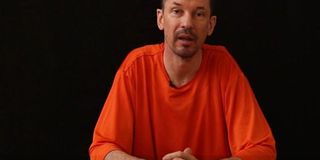Spare a thought for my journalist friend facing beheading for telling Syria’s story

An image grab taken from a video released by the Islamic State (IS) group through Al-Furqan Media via YouTube on September 18, 2014 allegedly shows British freelance photojournalist, John Cantlie, at an undisclosed location in which he says he is being held captive. PHOTO | AFP | AL-FURQAN MEDIA VIA YOUTUBE
What you need to know:
- It can be debated whether journalists who go into war zones take too many risks and whether, in the end, reporters should err on the side of caution and stay home.
- That debate has certainly been one of the features of the reaction to Cantlie’s online video because, in his case, it is the second time he has been captured by jihadists.
On the morning of February 16, 2012, I woke up in the room we shared with a number of journalists near the airport in Mogadishu and turned on the computer to check on what was happening in the world.
A story on the home page of the New York Times bore bad news from Syria.
The Lebanese-American journalist Antony Shadid who, together with Kareem Fahim and David Kirkpatrick did some of the best reporting during the Arab uprisings, had died in Syria, apparently from an asthma attack.
I turned to the British photographer seated not too far away and told him the story. “What? What happened to him?”
The report said he and photographer Tyler Hicks had been navigating the treacherous border between Syria and Turkey at night on horseback when Shadid suffered an asthma attack which proved fatal.
“Aaaargh! That doesn’t add up,” the photographer joked. “I bet Hicks strangled him and then claimed he suffered from asthma.”
It was the typical British habit of making light of everything, but then by that time I was used to the laidback journalist’s light-hearted approach.
The cameraman’s name was John Cantlie. On Thursday, I was astonished when I put on the news to see Cantlie’s face on television, pale, thin and unshaven, reading a video prepared by the Islamic State extremists who have made a name for their serial beheading of captives.
When Cantlie mentioned during our time in Somalia that he planned to go next to Syria, I recall asking him if it wasn’t too dangerous a place to report from and he replied, matter-of-factly. “But that’s where the big story is.”
It can be debated whether journalists who go into war zones take too many risks and whether, in the end, reporters should err on the side of caution and stay home.
That debate has certainly been one of the features of the reaction to Cantlie’s online video because, in his case, it is the second time he has been captured by jihadists.
The first time he and a Dutch colleague escaped with bullet wounds after being released from their captors by the more moderate Free Syrian Army.
WORK AROUND CONFLICT
Yet although Somalia is not nearly as dangerous a place as Syria, the experiences and lessons you draw from the ground cannot be replaced by covering the story from a distance, and journalists like Cantlie perform a valuable service.
In Mogadishu, one aspect of life in the city that struck me was the way that people have found a way to work around conflict and get on with their lives.
Small-scale trade thrives and neighbourhood associations find ways to do without national government services.
There is no Somalia Power and Lighting Company so instead businessmen buy huge generators and power their neighbours’ houses for a fee.
Residents, meanwhile, develop a system of gallows humour to deal with the problem of bombs and bullets zipping around them as they then were at the height of the confrontation between Amisom troops and Al-Shabaab.
“What happened to Abdi? Oh, he was hit by Yusuf. Where is Fatuma? Unfortunately, she was killed by Yusuf.” Yusuf, it turns out, is the nickname for a bullet, describing the whizzing sound it makes on its way to its target: tzzzsf.
Above all, you get to learn the stories of the people and can make a judgement on a country’s prospects.
In Somalia, there was hope in the story of returnees such as Mohamoud Farah Egal who told me he left America because he was distressed at the fact that his children saw themselves as Americans first and described the problems shown on TV about Somalia as affecting “dad’s people”.
Who, then, would fight for Somalia’s future? On the more dispiriting side there were the dozens of youth leaving, including one who told me he would never return because Somalia had become a badiyo (bush).
I fervently hope the ISIS militants spare Cantlie’s life. But if he is beheaded as was his colleague James Foley, he should not be condemned as a risk-taker but rather be viewed as someone who knew the risks yet took them to perform the valuable service of explaining the complex conflicts raging around the world.





